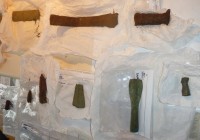 Archaeologists excavating the Royal Society for the Protection of Birds (RSPB) Scotland nature reserve on the Isle of Coll in the Inner Hebrides of Scotland have discovered a cache of 3,000-year-old broken bronze weapons.
Archaeologists excavating the Royal Society for the Protection of Birds (RSPB) Scotland nature reserve on the Isle of Coll in the Inner Hebrides of Scotland have discovered a cache of 3,000-year-old broken bronze weapons.
The excavation, directed by the Treasure Trove Unit in conjunction with National Museums Scotland and the RSPB, recovered twelve objects from at least seven swords and spears.
Jill Harden, RSPB Scotland Reserves Archaeologist, said: “This is the first discovery of this size from Argyll for many years. The items were recovered from what had once been a freshwater loch. It seems that they had been purposely broken and cast into the waters as part of a ceremony, most likely as offerings or gifts to the gods or goddesses of the time. It is recorded that bronze swords were found on Coll in the 19th century during drainage works, but their whereabouts today are unknown.”
Trevor Cowie, of National Museums Scotland’s Department of Scottish History & Archaeology, said: “While a fair number of objects from this period have been discovered in the west of Scotland in the past, we generally know very little about the precise places where they were found. Archaeological techniques have developed dramatically since those 19th century discoveries were made, so we have a great opportunity here to resolve many unanswered questions about life on Coll some 3,000 years ago.”
The weapons were on display briefly at the Isle of Coll’s An Cridhe community centre on Thursday and Friday of last week, but have been allocated to the Kilmartin Museum in Argyll for conservation where they will be stabilized and made ready for permanent exhibition to the public.
Jill Harden added: “It is expected that a consortium of local interests, universities and museums will come together to reveal the full history of these objects in time. However, their story is much broader than that of the items themselves. We should be able to reveal what Coll’s landscape was like in the past, how much it has altered over time, and whether there were contemporary environmental stresses that meant people resorted to making offerings to the gods in the hope of change.”
 That’s why the RSPB Scotland is involved in archaeological excavations of its lands in the first place, to increase understanding of the wider context and history of the environment.
That’s why the RSPB Scotland is involved in archaeological excavations of its lands in the first place, to increase understanding of the wider context and history of the environment.
The RSPB Scotland manages 1,075 hectares of mire, dunes, bog, machair and unimproved grassland on the Isle of Coll. This richly biodiverse ecosystem is home to rare birds including the skylark, twite, barnacle geese, Greenland white-fronted geese and most significantly the rare corncrake, a ground-dwelling bird once common in the UK which has been devastated by mechanical mowing of its tall grass breeding grounds. Working with local farmers, the RSPB Scotland has successfully increased the corncrake population in the Coll preserve just by making a few changes to farming practices like mowing the hay in August instead of July. Since the reserve was acquired in 1991, its corncrake population has more than quadrupled, although it’s still tiny at just 66 calling males.